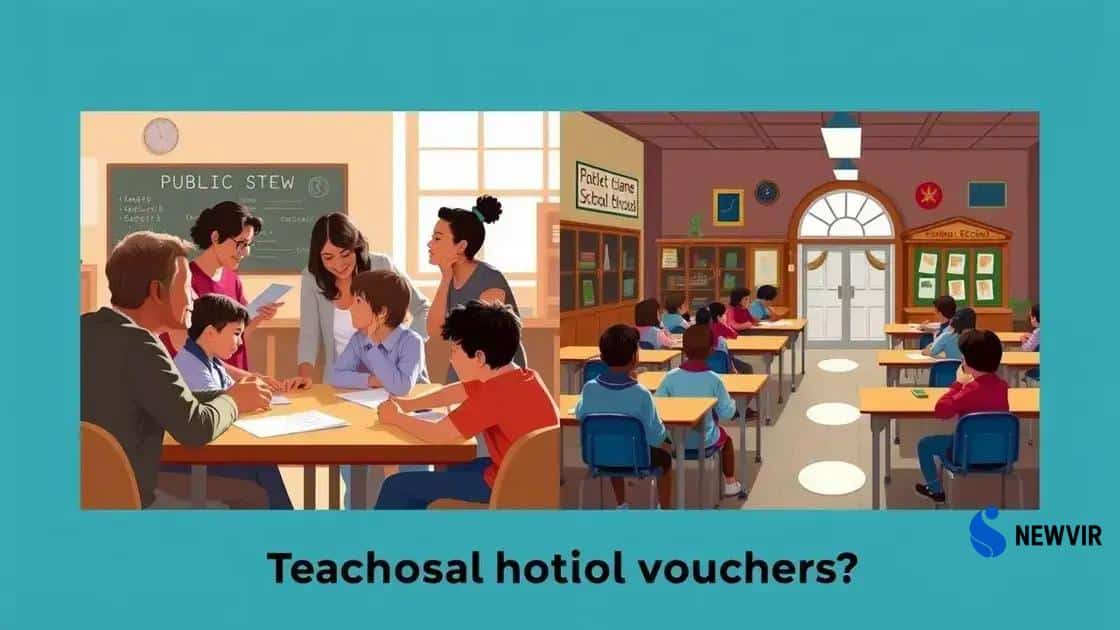School voucher expansion efforts in Texas: what you need to know

School voucher expansion efforts in Texas provide families with opportunities to choose schools, giving them control over their children’s education, but also raise concerns about funding and educational quality.
School voucher expansion efforts in Texas are sparking a heated debate. As the conversation evolves, how could these changes affect students and families? Let’s dive into the details.
Understanding school vouchers in Texas
Understanding school vouchers in Texas can seem complex, but it’s essential for families exploring educational options. These vouchers provide parents with the ability to send their children to schools of their choice, rather than being confined to their assigned public schools.
What Are School Vouchers?
School vouchers are government-funded scholarships that can be used to pay for tuition at private or charter schools. They aim to give families more control over their children’s education.
How Vouchers Work
Here’s a basic overview of how vouchers function:
- Parents apply for a voucher from the state.
- Once approved, they can use the voucher at a qualified school.
- The voucher amount typically covers a portion of the tuition.
In Texas, the specific rules and eligibility can vary. Some programs might target low-income families, while others may be available to a broader range of students.
Benefits of School Vouchers
Parents and advocates argue that school vouchers provide several advantages:
- Increased choices for families regarding education.
- Encouragement for schools to improve quality to attract students.
- Opportunity for children to attend schools better suited to their learning needs.
As more families consider this option, understanding the implications is crucial. School vouchers have sparked debates regarding their impact on public schooling.
Challenges and Criticisms
While there are benefits, some critics raise concerns about school vouchers. They argue that:
- Vouchers may divert funds from public schools.
- Not all schools accepting vouchers meet high educational standards.
- Access might still be limited for some low-income families.
Overall, analyzing both sides of the argument helps in making informed decisions about education.
Current legislation on voucher expansion
Current legislation on voucher expansion in Texas is a crucial topic for many families and policymakers. Recent proposals and bills have sparked discussions on how these changes might affect education.
Overview of Recent Bills
A few recent bills have been introduced aiming to expand the school voucher system. These bills focus on increasing accessibility for more families. By creating a framework that supports voucher programs, lawmakers seek to provide alternatives to public schooling.
Key Provisions of Proposed Legislation
The legislation typically includes several important provisions:
- Eligibility criteria for participating students.
- The amount of funding provided by the state per voucher.
- Requirements for private schools to qualify for the program.
By addressing these areas, lawmakers aim to ensure that the programs are beneficial and equitable.
Impact on School Funding
One of the significant concerns surrounding voucher expansion is its impact on public school funding. Critics argue that diverting funds to private schools can weaken public education systems. However, supporters claim that competition can drive improvements in educational quality.
Timeline for Implementation
If the current bills pass, there will be specific timelines for implementation. This process involves multiple steps, such as:
- Approval by state lawmakers.
- Establishment of guidelines for participating schools.
- Launching public marketing to inform families about their options.
As parents watch the developments closely, understanding the details can empower their choices in education.
Pros and cons of school voucher programs

When considering the pros and cons of school voucher programs, it’s important to understand both sides of the argument. These programs aim to give parents more control over their children’s education, but they also come with potential drawbacks.
Benefits of School Voucher Programs
One of the main benefits is the increased choice for families. Families can select schools that align with their children’s individual needs. This can lead to a better educational fit and improved student satisfaction.
Potential Advantages
Here are some key advantages:
- Increased competition: Schools may improve their quality to attract students.
- Access to private schooling: Families can afford private education that may have been out of reach.
- Encouragement for innovation: Schools are more likely to adopt new teaching methods and curricula.
These benefits suggest that vouchers can lead to a more dynamic educational landscape, encouraging schools to better meet the needs of students.
Drawbacks of School Voucher Programs
Despite the positives, there are also significant concerns associated with school vouchers. Critics point out that these programs can divert vital funding away from public schools, potentially harming the quality of education for students who remain in the public system.
Potential Disadvantages
Some of the key disadvantages are:
- Funding issues: Public schools may suffer from reduced financial resources.
- Accessibility: Not all families may be able to effectively use vouchers due to logistical challenges.
- Quality concerns: Some private schools receiving vouchers may not meet the same educational standards as public schools.
As the debate continues, weighing these pros and cons helps families make informed decisions about their educational options.
Impact on public and private schools
The impact on public and private schools as a result of school voucher programs is significant and multifaceted. Understanding these effects is crucial for families considering their options.
Effects on Public Schools
Public schools face challenges when voucher programs are introduced. One of the major concerns is the potential decrease in funding. As funds are redirected to private schools through vouchers, public schools may struggle to maintain their programs.
Key Consequences for Public Schools
Here are some key consequences for public schools:
- Reduced resources: Less funding can lead to larger class sizes and fewer extracurricular programs.
- Teacher retention: Lower budgets may result in cuts to staff, making it harder to retain experienced teachers.
- Balancing act: Schools must find ways to educate their students with dwindling resources.
These factors can create a challenging environment for educators and students alike.
Effects on Private Schools
On the flip side, private schools often benefit from the implementation of voucher systems. More families are able to afford tuition, which can lead to increased enrollment.
Key Advantages for Private Schools
Some advantages for private schools include:
- Increased enrollment: With more students able to afford tuition, schools can expand their programs.
- Funding opportunities: Additional governmental support may improve facilities and educational offerings.
- Innovation: Competition may lead to new programs that better serve student needs.
However, the expansion can also lead to pressures to meet standards set by voucher programs, which might impact educational quality and accessibility. Overall, the effects experienced by both sectors highlight the complexity of school voucher programs.
What families need to know about vouchers
When considering school vouchers, there are important details that families need to know about vouchers. Understanding how these programs function can help parents make informed choices for their children’s education.
Eligibility Criteria
First, families should be aware of the eligibility criteria for school vouchers. Each program may have specific requirements that dictate who can apply. Common factors include:
- Income level: Some programs are designed for low to middle-income families, making financial information critical.
- Residency: Many states require families to reside within specific districts or zones.
- School performance: Certain vouchers may only be available for students attending underperforming schools.
Knowing these criteria is essential for families thinking about applying for vouchers.
Application Process
The application process for school vouchers can vary significantly. Typically, parents will need to apply during a specific enrollment period. This often involves filling out forms and submitting proof of eligibility. Many families also find it helpful to:
- Gather necessary documents: Keeping income statements and residence proof organized can speed up the process.
- Research schools: Understanding which schools accept vouchers and their performance ratings is important.
- Attend informational sessions: These can provide insights directly from the administrators overseeing voucher programs.
These steps can help streamline the within the application process.
Potential Costs
While vouchers can help cover tuition, families should also consider potential costs not included in the voucher. Expenses such as uniforms, transportation, and materials can add up quickly. Understanding the full financial picture ensures families are prepared for additional financial responsibilities.
Choosing the Right School
Ultimately, when utilizing a voucher, selecting the right school plays a critical role in a child’s education. Families should evaluate schools based on:
- Academic performance: Research school rankings and test scores.
- Extracurricular offerings: Consider what activities are available outside the classroom.
- School culture: Visiting schools can help assess the environment and fit for a child.
By thoroughly considering these factors, families can make the best use of the voucher system to enhance their children’s educational opportunities.
In conclusion, understanding school vouchers is essential for families exploring educational choices. These programs can offer greater flexibility and potential benefits, but they also come with challenges. By considering eligibility, costs, and school quality, families can make informed decisions that suit their needs. Staying informed about the pros and cons of voucher programs can help ensure a brighter educational future for their children.
FAQ – Questions About School Voucher Programs
What are school vouchers?
School vouchers are government-funded scholarships that allow families to use public education funds for private or charter schools.
Who is eligible for school vouchers?
Eligibility varies by program but often includes income requirements and residency within specific districts.
What costs do vouchers cover?
Vouchers typically cover tuition but may not include additional expenses like uniforms, transportation, or supplies.
How can parents choose the right school?
Parents should research school performance, extracurricular options, and visit schools to assess the environment before making a decision.






